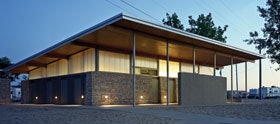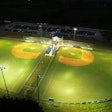Providing bathrooms for outdoor recreation can be a dirty job, and it also may be a necessary one.

Log in to view the full article
Providing bathrooms for outdoor recreation can be a dirty job, and it also may be a necessary one.

The fact is, many parks and recreation providers see public restrooms as maintenance hogs. And funding for restroom construction or renovation - let alone maintenance - is often found at the bottom of capital-improvement wish lists. Public comfort stations serving parks and other outdoor recreation facilities were at one time ubiquitous, but the building codes requiring even private businesses to allow public use of indoor restrooms changed that. But today, says Brubaker, many government agencies are once again recognizing the benefits of investing in bathrooms that serve users of outdoor athletics and recreation facilities.
"We're not saying there isn't a cost involved," says Brubaker, whose organization is one of 42 representatives of the World Toilet Organization, which advocates for public sanitation facilities. "What we're trying to show is that there is a need, and that there are advantages to meeting it. Without the facilities, there are a lot of people who simply are not going to use parks - and there's no way around that."
Parks and recreation agencies throughout the country are overcoming financial challenges to meet that need. In June, the Tyler, Texas, city council approved spending more than $1 million in sales tax revenue to install 13 prefabricated restroom structures in city parks. "Most of our park restrooms are 20 to 30 years old," Tyler Parks and Recreation Department manager John S. Webb told the city's Half-Cent Sales Tax Board, according to Tyler Morning Telegraph reports. "They are nasty and need to be replaced."
Officials in Milwaukee County, Wis., are in the process of evaluating each of the county's 144 existing restrooms, which come in all shapes and sizes and are spread among multiple marinas, six beaches, 15 golf courses, 40 swimming pools and other parks and recreation facilities comprising 1,500 acres.
To tackle the large job, county parks and recreation department director Sue Black and her staff launched a program that had already worked to fund the reconstruction and renovation of the county's playgrounds. For bathrooms, the process involves a 25-point check of a number of building elements such as walls, roofs, partitions, sinks, toilets and individual plumbing components, as well as HVAC system performance and ADA accessibility compliance. "Our staff met with plumbers and electricians as a group, but we had one person do the evaluations, so that each one was judged from the same frame of reference," says Black. "What we want is baseline data."
Based on the findings, each county park bathroom was given a letter grade. F-graded facilities were pegged first for a needs assessment and, if need be, repair or replacement, and were followed in order by Ds, Cs, Bs and As. Black's department approached the county's governing board armed with the knowledge that renovating the 11 existing F-graded bathrooms would cost $862,000. "Grading them and working them backward is the key to addressing these kinds of infrastructure issues," says Black. "Nothing gets skipped over. The most important thing is getting that line item in your budget - the policy-makers and the people setting your budget can see that you're working systematically."
But Black isn't convinced that all the county's bathrooms are still necessary commodities, given that any manner of public and private developments sprung up around them in the past decades. "The first critical question is, 'Do we still need this facility, or don't we?' If it's at our marinas or our outdoor pools, absolutely. If it's at a more remote location, then it's questionable."
The question usually focuses on demand, which can be difficult to determine when the facilities are outdoors. The National Park Service cost-efficiently determines park restroom demand by 1) recording complaints and other feedback from park users about the lack of toilet facilities in a location, and 2) placing portable sanitation units (PSUs) in that location and monitoring their use based on the volume of waste removed.
As a result of such intelligence gathering, several national parks now feature waterless composting toilets in which a tank holds waste while it breaks down into organic compost. Due to the composting process, the volume of solid waste is greatly reduced, requiring less frequent removal than is necessary for chemical toilets, which describes most PSUs.
Some state parks have also embraced new trends in outdoor restrooms. As part of its Green Initiatives program, which relies in part on federal and state grants, the Michigan Department of Natural Resources is opening new energy- and water-efficient restroom and shower structures. In May, Otsego State Park unveiled a bathroom structure designed by Grand Rapids-based Integrated Architecture LLC that features all natural lighting during the day, occupancy sensor-triggered nighttime lighting, timer-controlled showerheads and low-flow plumbing fixtures. Rooftop solar panels also reduce energy consumption. Another green bathroom and shower structure, at Traverse City State Park, features low-volatile-organic-compound paints and sealants, as well as recycled products manufactured within the state.
Many parks departments are looking to replace their brick-and-mortar restroom buildings with more affordable prefabricated structures, which Brubaker says often function well. "Some of these units are fairly indestructible," he says. "And they tend to meet all the structural requirements, including ADA. They're relatively well designed from the standpoints of vandalism, airflow, and cleaning and maintenance."
Even PSUs are fairly well regarded in the industry. "We have found that for all the complaining users do about portable toilets, they do use them and they do appreciate them," says Brubaker. "And they are a relatively cheap solution."
Black, for one, finds it handy to contract with a PSU provider when her department stages large events in open park spaces that otherwise see little demand for restroom facilities. "It's kind of like you wouldn't want to build a campground just for the Fourth of July," says Black. "I think sometimes it's much more advantageous to have a company come in from the outside, bring in the PSUs and pull them out, than it is to have a four- or six-unit structure that's not going to be able to meet the needs of that event anyway."
ADA-compliant PSUs also can provide accessibility solutions to parks providers by standing alongside non-compliant brick-and-mortar facilities, although Brubaker warns that the strategy has not yet been tested in any high-profile court cases.
Regardless of the bathroom style, Brubaker argues that parks and rec providers invariably undervalue the presence of comfort stations serving outdoor areas. He cites feedback from ETC Institute - a Kansas City-based market-research firm that regularly administers surveys on behalf of government organizations - suggesting that parks providers often try to avoid the restroom issue.
"A bicycling organization recently did a survey of about 1,000 people, asking what amenities they'd like to see in their parks," says Brubaker. "New and better bathrooms ranked number two out of about 40 choices."
That high priority for new and better bathrooms is typical in such surveys. However, says Brubaker, parks and rec professionals often omit that question from surveys related to parks amenities. "They literally make sure it doesn't get asked, because they don't want to hear the answer," he says. "Also, if you ask people an open-ended question about what they want, they'll almost never mention bathrooms. But if bathrooms is put into a list of choices, it tends to get a very high ranking."
Brubaker suggests that parks providers should not view outdoor restroom facilities as necessary evils, but as important elements to an infrastructure that will maximize park usage and rec program participation.
"What's happening now is we're seeing an emphasis on walkable, livable communities," he says. "You could have a young woman taking a jog or an older couple playing tennis, and they don't want to have to drop into a Starbucks to get to a toilet. There's an idea that you're getting rid of impediments to fitness. We've seen plenty of evidence that people will hesitate to participate in certain physical activities if they think it will put them out of range of a toilet."




































